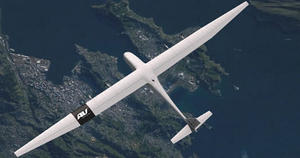UAV updateNew generation of UAVs being tested
These are not your father’s UAVs; a new generation of UAVs represent a major technological advance over the Predator and Reaper drones that the Obama administration has deployed as a central element of the U.S. military campaign in Afghanistan; unlike most of the current fleet of more than 7,000 drones, the new remotely piloted planes will have jet engines and the ability to evade enemy radar; three members of the new generation of drones being flown in the coming weeks are speedier, stealthier, and higher-flying than their predecessors

Unmanned, with the wingspan of a Boeing 747 // Source: avinc.com
An experimental spy plane with a wingspan almost the size of a Boeing 747’s took to the skies over the Mojave Desert last week in a secret test flight that may herald a new era in modern warfare with robotic planes flying higher, faster and with more firepower.
The massive Global Observer built by AeroVironment Inc. of Monrovia, California, is capable of flying for days at a stratosphere-skimming 65,000 feet, out of range of most antiaircraft missiles. The plane is built to survey 280,000 square miles — an area larger than Afghanistan — at a single glance. That would give the Pentagon an “unblinking eye” over the war zone and offer a cheaper and more effective alternative to spy satellites watching from outer space.
The estimated $30-million robotic aircraft is one of three revolutionary drones being tested in coming weeks at Edwards Air Force Base.
Another is the bat-winged X-47B drone built by Northrop Grumman Corp., which could carry laser-guided bombs and be launched from an aircraft carrier. The third is Boeing Co.’s Phantom Ray drone that could slip behind enemy lines to knock out radar installations, clearing the way for fighters and bombers.
The Los Angeles Times reports that these aircraft would represent a major technological advance over the Predator and Reaper drones that the Obama administration has deployed as a central element of the U.S. military campaign in Afghanistan. Unlike most of the current fleet of more than 7,000 drones, the new remotely piloted planes will have jet engines and the ability to evade enemy radar.
“We are looking at the next generation of unmanned systems,” said Phil Finnegan, an aerospace expert with Teal Group, a research firm. “As the U.S. looks at potential future conflicts, there needs to be more capable systems.”
Finnegan pointed out that propeller-driven Predator and Reaper drones are not fast or stealthy enough to thread through antiaircraft missile batteries.
Boeing’s Phantom Ray and Northrop’s X-47B, by comparison, “can enter contested air space, attack the enemy, and leave without detection on a radar screen,” he said.
The Global Observer that was tested last week is designed for reconnaissance and would not carry weapons. It would greatly extend the surveillance capabilities of drones.
Current spy planes can stay airborne for only about thirty hours. The Global Observer is designed to beat that mark several times over, flying up to a week at a time, and company officials say it may be ready to
